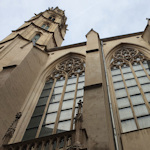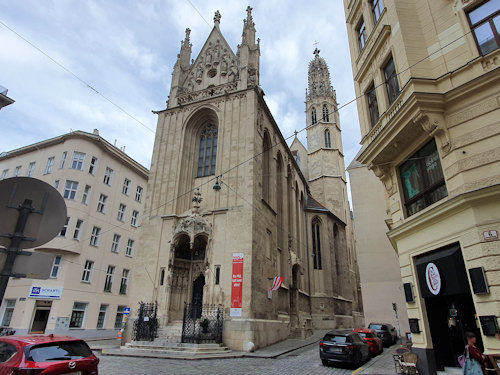
Names can be deceptive. Take, for example, the Maria am Gestade church, which really ought to be serving river folk on some pebbled shore and not sitting on a rise in the centre of Vienna.
- Gothic church (second-oldest in Vienna)
- Known for its unique tower and structural kink
- Named for a location that no longer exists
- Appeared in The Third Man
- Book a cathedral concert* in Vienna
- See also:
(Not) down by the river

(The narrow church now hemmed in by “modern” Vienna)
In German, the Gestade is the shore of a river or sea. So the Maria am Gestade translates to something like Maria by the Shore. Which comes as a surprise when you stand next to the church, as there’s no shore (or water) anywhere in sight.
To be fair, a small arm of the Danube (the Donaukanal) drifts past a couple of streets away. But the church’s location still seems to reflect a rather flexible definition of a riverbank.
Only two possibilities can explain the confusion: either the church moved or the river did. Neither seems likely.

(The Gothic tower seen from the distance)
As it turns out, though, part of the Danube river complex did indeed decide to change course.
In previous centuries, the lack of waterway regulation meant rivers would often shift position after floods or other moments of hydrological excitement.
The Danube, for example, used to pass along the very edge of Vienna’s old town, which would explain the church’s name. But the main arm shifted away leaving the less-impressive Danube canal behind.

(The church in the 1730s; Salomon Kleiner (drawer), Johann Andreas d. Ä. Pfeffel (publisher), Johann Georg Ringlin (copper engraver), Prospect der Passauischen Pfarr-Kirchen zu Unser Lieben Frauen-Stiegen (Maria am Gestade), from Wahrhafte und genaue Abbildung (…), 3. Teil, Abb. 1, 1733, Wien Museum Inv.-Nr. 105765/72; reproduced with permission under the terms of the CC0 licence)
The original shoreside spot also accounts for the church’s tall and narrow design and the kink in the structure. Stand at one end of the church and something feels not quite right: the nave and choir fail to line up perfectly.
It almost feels as if they merged two churches together by knocking down a wall between them.
The Gothic look of the place is part genuine, part renovation. Nobody knows quite when the church first appeared, but sometime before the 1130s seems likely.

(Part of the Albertinian map from sometime after 1460 (based on a document from 1421/22). Maria am Gestade used to be known under other names and is pictured here I believe as the abbreviated “Zu unser liebe Frau…”; Wien Museum Inv.-Nr. 31018; excerpt reproduced with permission under the terms of the CC0 licence)
Various rebuilding and extension works followed as well as a checkered history that included a short period serving as a stable for Napoleon’s army.
The most striking feature is possibly the early 15th-century openwork tower, which marks Maria am Gestade from a distance and often dominates the skyline on old representations of the city.
Today, the Redemptorist catholic order runs the church, which has Austrian, French, and Czech congregations.
Church as film star?

(Holly Martins runs up here looking to escape his unsavoury pursuers)
Maria am Gestade may be the second-oldest church in Vienna (after the Ruprechtskirche) but it still enjoys a little contemporary fame as a Hollywood location.
For example, Holly Martins uses the steps leading up to the church in The Third Man. And the young lovers in Before Sunrise visit the building (exterior shot only!) as they wander through Vienna.
(Talking historical, Judenplatz square is just around the corner: home to one of the Jewish Museum sites and the remains of a medieval synagogue.)
How to get to Maria am Gestade
Subway: the church manages to be just about equidistant to five stations without being immediately close to any of them. It’s a bit of a walk from Schottenring (U4 and U2 lines), Schottentor (U2), Stephansplatz (U1 and U3), Schwedenplatz (U1 and U4) and Herrengasse (U3).
Tram/bus: tram 1 to Salztorbrücke or Börse (the D and 71 also serve the latter stop). Buses stop very close indeed. For example the 3A (Concordiaplatz or Schwertgasse), 2A (Tiefer Graben), or 1A (Schwertgasse).
Address: Salvatorgasse 12, 1010 Vienna | Website